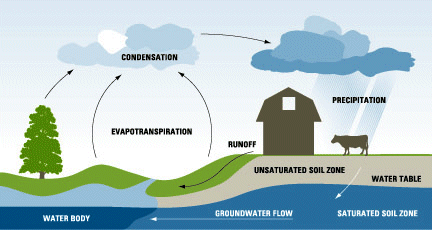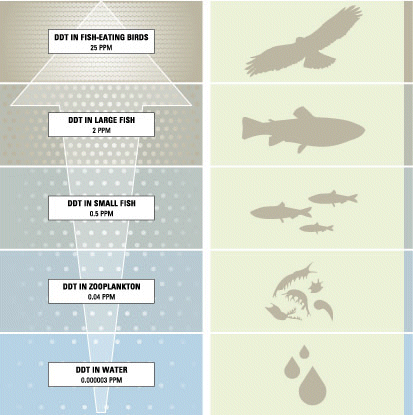| | Nutrients: phosphorus and nitrogen | Pathogens | Pesticides | Sediments | Other Contaminants
Crop production can affect water quality if water carries contaminants from fields to surface water or groundwater. Precipitation that falls on the field either as snow or rain can take several paths (Figure 2.6). It can be stored as snow and ice or in puddles, it can flow across the land as overland flow, or it can seep into the ground by infiltration.
Water that seeps into the ground may be stored in an unsaturated zone as soil moisture where it is available for plant use, or it may move down to the groundwater. Under some conditions, water can move laterally in a saturated zone as interflow. The term runoff includes both overland flow and interflow.

Figure 2.6. Water cycle
Adapted from Figure 2-1 in Coote, D.R. and Gregorich, L.J. (eds). 2000. The Health of Our Water: Toward Sustainable Agriculture in Canada. Agriculture and Agri-Food Canada, Publication 2020/E. Reproduced with the permission of the Minister of Public Works and Government Services Canada, 2003.
When water leaves a field by runoff or gravity drainage, it can potentially carry contaminants - such as nutrients, disease-causing organisms, pesticides, sediments, or fuel - to water sources. Surface water sources are most vulnerable to contamination from overland flow and interflow, whereas groundwater sources are most vulnerable to contamination through leaching. Contaminants may be dissolved in water, or they may be attached to soil particles and carried away during soil erosion events.
Nutrients: Phosphorus and Nitrogen
Phosphorus and nitrogen are two nutrients that are essential for plant growth and crop production. Both nutrients are components of chemical fertilizers, animal manures and decomposing crop residue. In soil, they are found dissolved in soil water, attached to soil particles or as particles of fertilizer.
Nitrogen and phosphorus can be transported by runoff and leaching to surface water and groundwater. Elevated levels of these nutrients degrade water quality by promoting growth of rooted aquatic plants and algae.
Phosphorus is the nutrient that most greatly affects aquatic plant growth. Even a small amount of phosphorus, measured in parts per billion, can promote the growth of algae and other aquatic plants. Large masses of algae, called algal blooms, are a key concern for several reasons:
- When algal blooms exhaust the supply of phosphorus, they die and start to decompose. During decomposition, dissolved oxygen is removed from the water by microorganisms that break down the organic material. The lack of oxygen can result in the death of fish and other aquatic organisms.
- Some types of blue-green algae can release toxins deadly to livestock and humans when the algal bloom decomposes.
- Algae can block water intakes, reduce the appeal of water bodies for recreation, and give an unpleasant taste and odour to drinking water.
Nitrate is a form of nitrogen that is highly susceptible to leaching because it is readily dissolved in water. Drinking water guidelines place an upper limit on the allowable concentration of nitrate (10 mg/L of nitrate-nitrogen) in water because high concentrations can pose health hazards to humans and livestock. Ammonia, another form of nitrogen, poses a threat to water quality because it can be toxic to aquatic organisms such as fish.
Factors affecting the transport of nutrients to surface water and groundwater:
- Areas at greater risk of water erosion (see Water Erosion) are also at greater risk for contributing nutrients to runoff and surface waters.
- Infiltration of water is slower in fine-textured soils (silty and clay soils), making them more likely to have runoff, and increasing the risk of surface water contamination. Infiltration is faster in coarse-textured soils (sandy soils) and more likely to lead to groundwater contamination.
- Wet soils that are frozen have lower infiltration, which can lead to increased runoff and a greater risk of surface water contamination.
- Permanent vegetation cover along the banks of a surface water body can capture some of the nutrients in runoff.
- If there is an excess concentration of a particular nutrient, then there is a greater risk of transport of that nutrient.
Pathogens
A pathogen is a disease-causing microorganism. Three classes of microorganisms are important in disease transmission via water: bacteria, viruses and parasites. Pathogens found in contaminated water may include strains of Escherichia coli, Camphylobacter species, Salmonella species, Shigella species, Cryptosporidium parvum and Giardia lamblia.
Livestock manure can harbour a number of these pathogens. Runoff from manured fields can carry the pathogens to surface waters, and leakage from improper manure storage can potentially contaminate surface water and groundwater.
Ingestion of pathogens from manure can lead to various illnesses in humans. Most pathogens in water can be killed through disinfection with chlorine; however, some pathogens, including Cryptosporidium parvum, are resistant to chlorine and require more expensive treatment methods.
Factors affecting the transport of pathogens to surface water and groundwater:
- Areas at greater risk of water erosion (see Water Erosion) are at greater risk for contributing pathogens to surface water.
- Areas with a greater risk of contributing nutrients from manure to surface waters are also at greater risk of contributing pathogens.
- Downward movement of water is slower in fine-textured soils, making them more likely to have runoff and a greater risk of contributing contaminants to surface waters. Downward movement of water in coarse-textured soils is faster and more likely to lead to leaching and a greater risk for shallow groundwater contamination.
- Wet soils that are frozen have lower infiltration, which can lead to more runoff and a greater risk for contributing pathogens to surface water.
Pesticides
Pesticides are chemicals designed to control or kill specific plants, insects, animals and disease-causing organisms. Pesticides can be grouped into herbicides, insecticides, fungicides and rodenticides.
Pesticides can be harmful to organisms other than the target organism. When the pesticides are transported to water, any organism that resides in the water or ingests the water comes into contact with the pesticide. While some pesticides degrade quickly in the environment, others can accumulate in the tissue of organisms, in a process called bioconcentration. With every step in the food chain, larger quantities of the accumulated pesticide are eaten. This accumulation, called biomagnification, may continue to the point where the animals are harmed or are unsafe for human consumption (Figure 2.7).

Figure 2.7, Biomagnification
Over-reliance on certain pesticides can also lead to the development of resistance in the target species.
Pesticides can be carried from the target area to water bodies in several ways: dissolved in runoff water or infiltrating water, as soil-attached particles carried by wind or runoff water, or as spray drift (see Pesticide Drift).
Factors affecting transport of pesticides to surface water and groundwater:
- Heavy rainfall soon after a pesticide application greatly increases the risk of contaminating runoff and groundwater, and also reduces the effectiveness of the pesticide application.
- Pesticides can reach surface water directly through spills or improper mixing/loading techniques. In particular, backflow, the backward flow of liquid from the sprayer through the filling hose when the pump is shut off, can cause serious contamination of the water source used for mixing.
- Pesticides that are very soluble have a greater potential to percolate through the soil and reach the groundwater.
- Areas at greater risk for erosion (see Soil Erosion) are at greater risk for the movement of soil-attached pesticides.
Table 2.4 provides more details on the factors affecting the transport of pesticides to water bodies.
Table 2.4. Factors affecting pesticide transport to water
| Chemical Factors | Solubility | Soluble pesticides will move easily with water and are more likely to leach through soil. |
| Binding to soil particles | Some chemicals adhere very tightly to soil particles and are not subject to loss by dissolving into water, but can be carried to water bodies through erosion of soil particles. |
| Rate of breakdown (half life) | A persistent chemical, because it is around longer, is more likely to be transported than one that breaks down quickly. |
| Rate of application | A chemical with a low application rate is less likely to move away from the target. |
| Timing of application | Chemicals applied in the fall or early spring have a greater chance of loss. |
| Soil Factors | Texture | Sandy soils, which allow greater water movement and bind less tightly to chemicals, are subject to more losses. |
| Slope | Steep slopes that are erosion prone are more likely to lose pesticides that are attached to soil particles. |
| Depth to water table | Shallow water tables are more easily contaminated. In the spring and fall when water tables are high, chemicals are more likely to move downward and contaminate the groundwater. |
| Application Factors | Weather following spraying | Heavy rain within a few days of spraying can move significant proportions of the applied chemicals. |
| Operator care | Excessive rates, uncalibrated sprayers, careless handling, spraying too close to streams or lakes, or spraying when it is too windy can all increase losses. |
Adapted from: Agriculture and Agri-Food Canada and Ontario Ministry of Agriculture and Food. 1992.
Best Management Practices: Field Crop Production. Agriculture and Agri-Food Canada and Ontario Ministry of Agriculture and Food. p. 36.
Sediments
Sediments are soil particles carried by runoff and deposited in water bodies. Sediments can eventually fill in the water body where they are deposited. They can also degrade aquatic habitat and reduce water quality.
Sediment deposition can smother fish eggs, aquatic larvae and other aquatic organisms. Increased sediment in water reduces light penetration, which may inhibit the growth of bottom-rooted aquatic plants, resulting in a shift toward the growth of algae.
Sediments suspended in water decrease the effectiveness of chemical water treatment methods, resulting in the need for expensive pre-treatment of drinking water. Other contaminants, such as nutrients, pesticides, pathogens, or fuel compounds, can be attached to sediment particles, further reducing water quality.
Factors affecting transport of sediments to surface water:
- Areas at greater risk of soil erosion (see Soil Erosion) are also at greater risk for movement of sediments into surface waters.
- Vegetation along the banks of a water body stabilizes the bank, reducing the risk of erosion by the stream. Bank vegetation also traps sediments carried by runoff, preventing them from entering the water body.

Damaged stream banks contribute sediments to the stream, damaging the aquatic habitat.
Courtesy of Cows and Fish Program
Other Contaminants
Fuels, lubricants, solvents, and paints can be a source of pollution. The most common way for these contaminants to enter surface water or groundwater is through spills or leakage.
Most paint, fuels, lubricants and solvents are toxic to aquatic organisms, and many of these compounds are also toxic to other organisms, including humans, when ingested. Products such as gasoline, diesel fuel and kerosene can move quickly through the soil and into groundwater. It takes only a few litres of gasoline to severely pollute a farmstead's drinking water.
Factors affecting transport of other contaminants to surface water and groundwater:
- Contaminants such as fuels, solvents and paints are easily transported by runoff to surface water bodies and by seepage to groundwater.
- Areas at greater risk of water erosion (see Water Erosion) are also at greater risk for the movement these contaminants in runoff.
- Infiltration of water is slower in fine-textured soils, making them more likely to have runoff leading to a greater risk of surface water contamination. Infiltration in coarse-textured soils is faster and more likely to lead to groundwater contamination.
- Wet soils that are frozen have limited infiltration, which can lead to more runoff and a greater risk of transportation to surface water bodies.
- For more information on water quality, see The Health of Our Water (AAFC), Primer on Water Quality (ARD).
Back to Chapter 2 - Environmental Considerations |
|